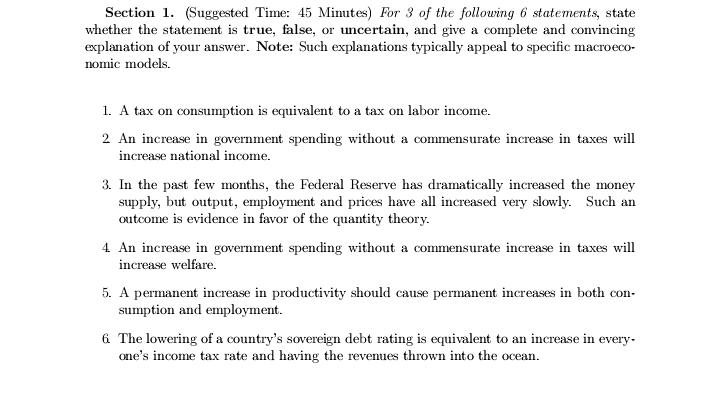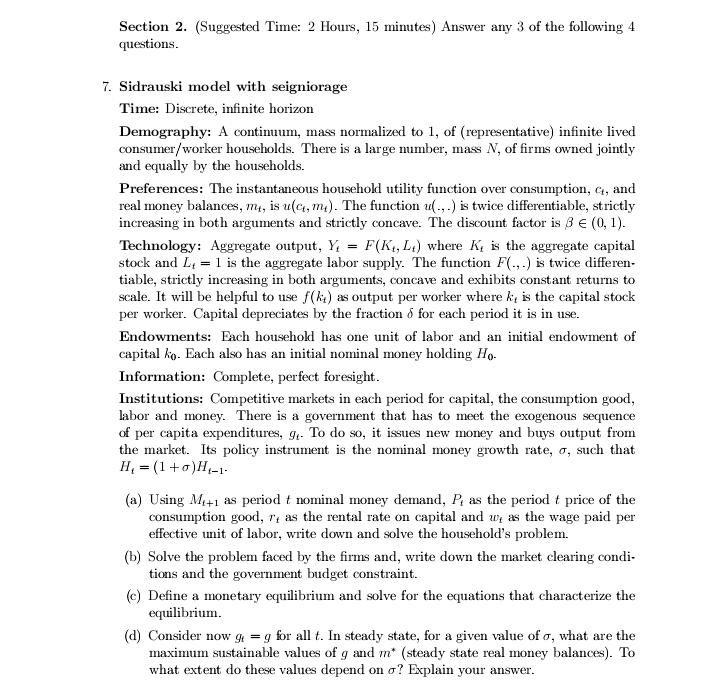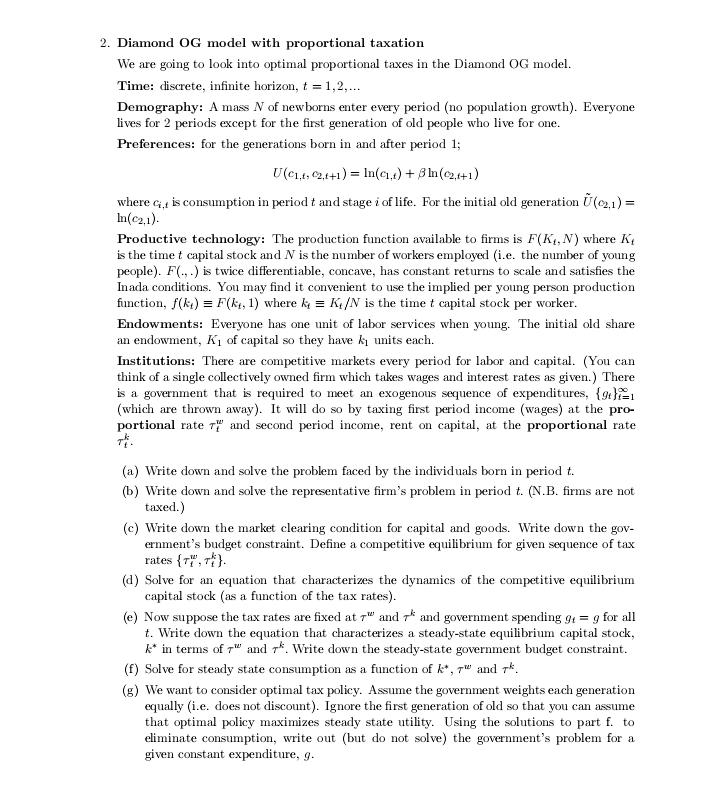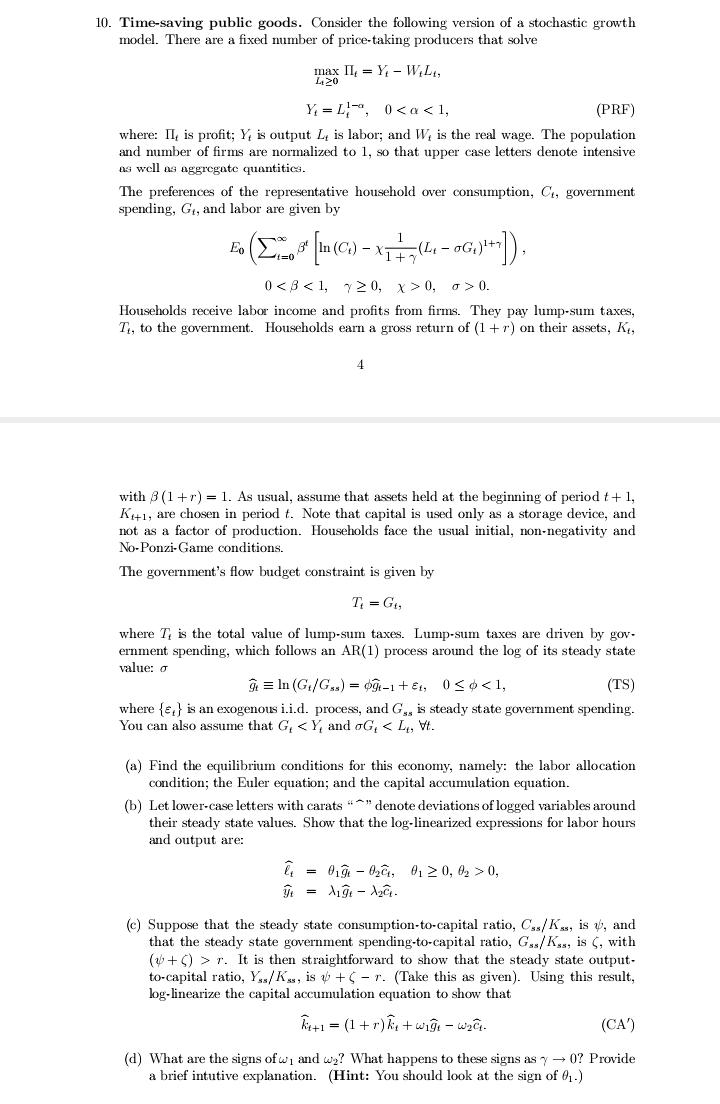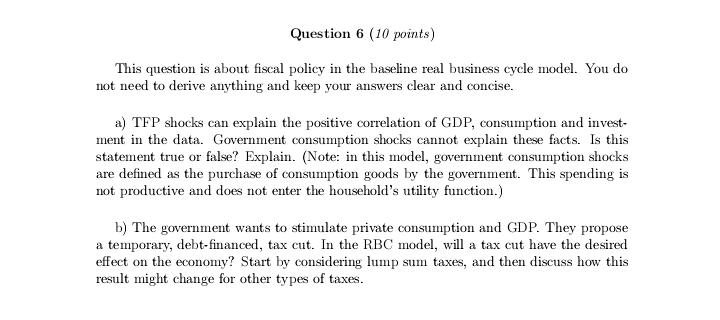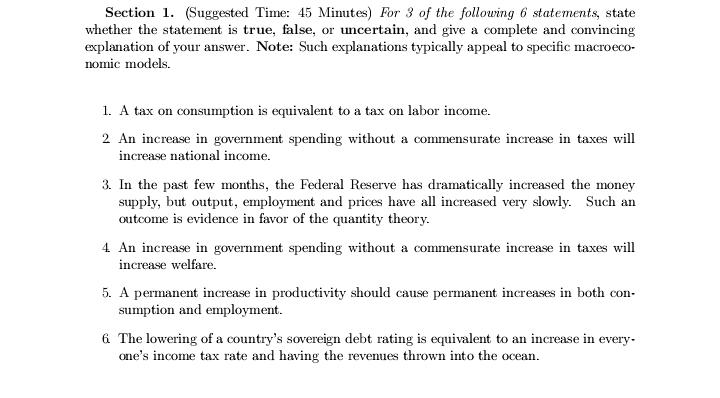
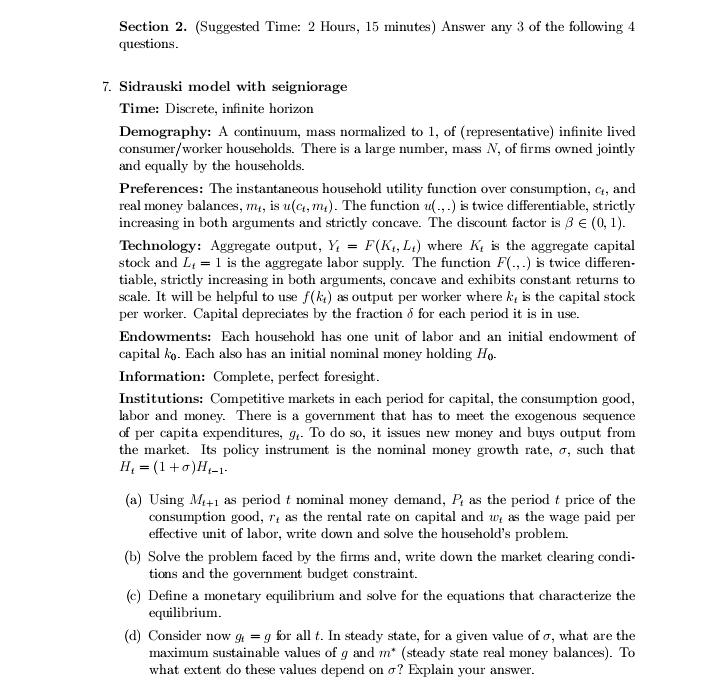
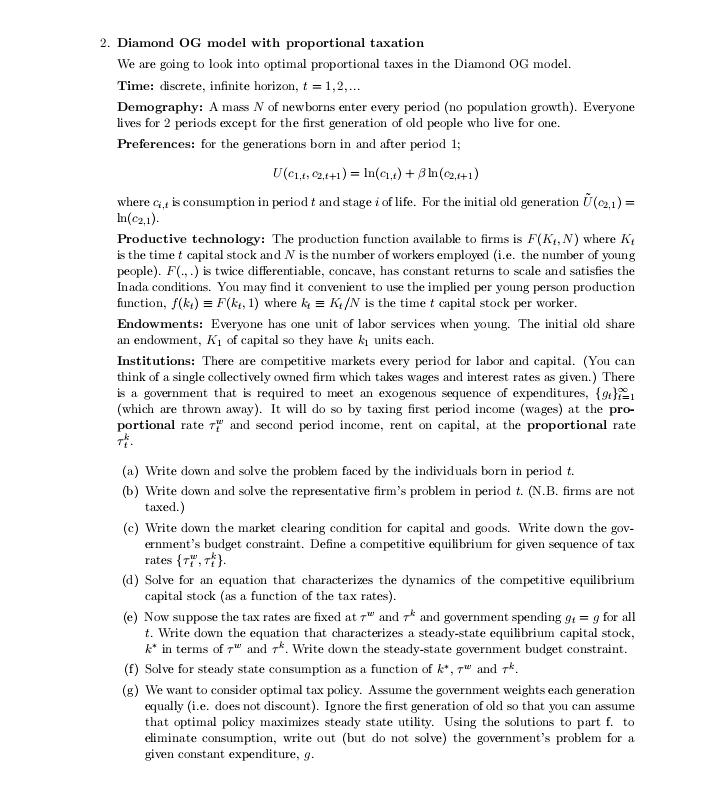
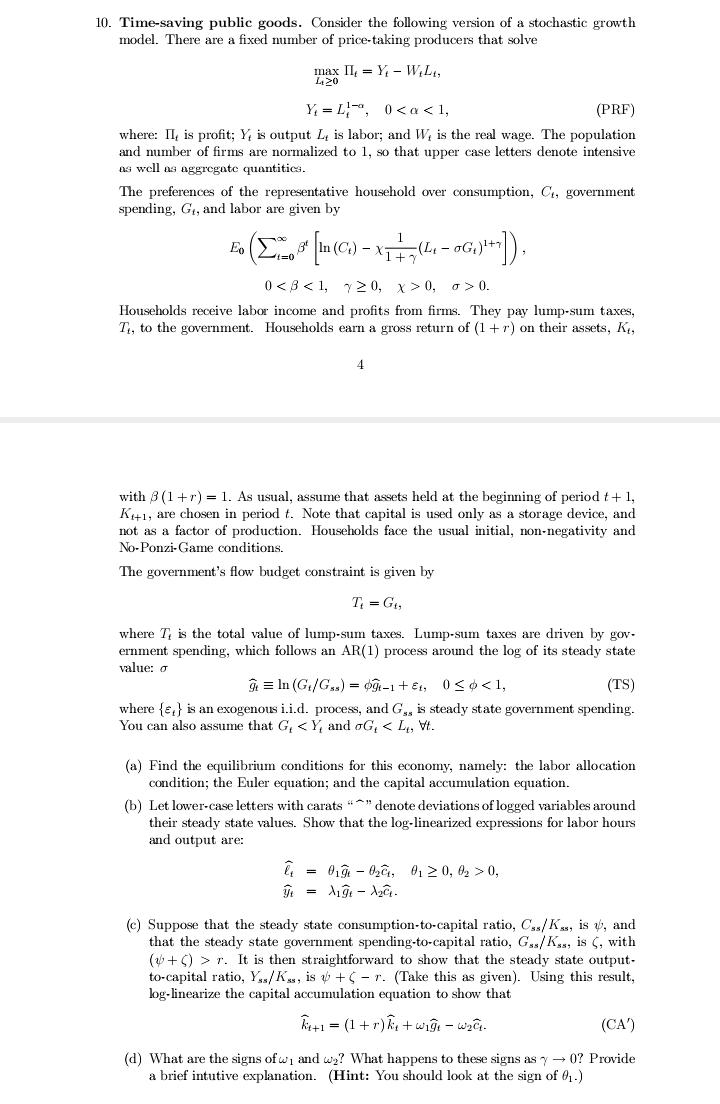
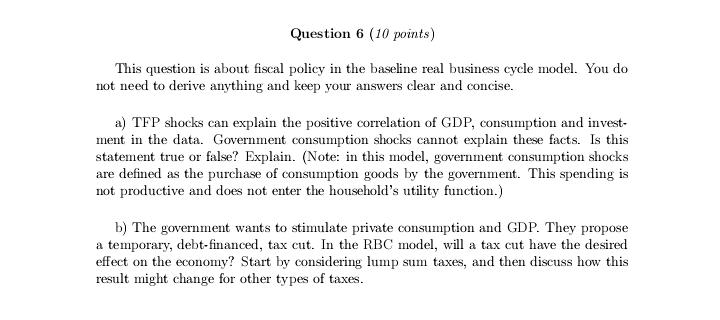
Help me to understand this..
Section 1. (Suggested Time: 45 Minutes) For 3 of the following 6 statements, state whether the statement is true, false, or uncertain, and give a complete and convincing explanation of your answer. Note: Such explanations typically appeal to specific macroeco- nomic models. 1. A tax on consumption is equivalent to a tax on labor income. 2 An increase in government spending without a commensurate increase in taxes will increase national income. 3. In the past few months, the Federal Reserve has dramatically increased the money supply, but output, employment and prices have all increased very slowly. Such an outcome is evidence in favor of the quantity theory. 4 An increase in government spending without a commensurate increase in taxes will increase welfare. 5. A permanent increase in productivity should cause permanent increases in both con- sumption and employment. 6 The lowering of a country's sovereign debt rating is equivalent to an increase in every- one's income tax rate and having the revenues thrown into the ocean.Section 2. (Suggested Time: 2 Hours, 15 minutes) Answer any 3 of the following 4 questions. 7. Sidrauski model with seigniorage Time: Discrete, infinite horizon Demography: A continuum, mass normalized to 1, of (representative) infinite lived consumer/worker households. There is a large number, mass N, of firms owned jointly and equally by the households. Preferences: The instantaneous household utility function over consumption, G, and real money balances, my, is u(c, my). The function u(., .) is twice differentiable, strictly increasing in both arguments and strictly concave. The discount factor is B e (0, 1). Technology: Aggregate output, Y = F(K,, L,) where K, is the aggregate capital stock and L, = 1 is the aggregate labor supply. The function F(., .) is twice differen- tiable, strictly increasing in both arguments, concave and exhibits constant returns to scale. It will be helpful to use f(k) as output per worker where k, is the capital stock per worker. Capital depreciates by the fraction s for each period it is in use. Endowments: Each household has one unit of labor and an initial endowment of capital ko. Each also has an initial nominal money holding Ho- Information: Complete, perfect foresight. Institutions: Competitive markets in each period for capital, the consumption good, labor and money. There is a government that has to meet the exogenous sequence of per capita expenditures, g- To do so, it issues new money and buys output from the market. Its policy instrument is the nominal money growth rate, o, such that H, = (1+0)H;-1- (a) Using Me1 as period t nominal money demand, P, as the period t price of the consumption good, ", as the rental rate on capital and my as the wage paid per effective unit of labor, write down and solve the household's problem. (b) Solve the problem faced by the firms and, write down the market clearing condi- tions and the government budget constraint. (c) Define a monetary equilibrium and solve for the equations that characterize the equilibrium. (d) Consider now g = g for all t. In steady state, for a given value of o, what are the maximum sustainable values of g and m* (steady state real money balances). To what extent do these values depend on o? Explain your answer.2. Diamond OG model with proportional taxation We are going to look into optimal proportional taxes in the Diamond OG model. Time: discrete, infinite horizon, t = 1,2,... Demography: A mass N of newborns enter every period (no population growth). Everyone lives for 2 periods except for the first generation of old people who live for one. Preferences: for the generations born in and after period 1; U(cit, (2,t+1) = In(q,() + Bl(c2,#+1) where Gor is consumption in period t and stage i of life. For the initial old generation U(cz,1) = In(c2,1). Productive technology: The production function available to firms is F(K, N) where K, is the time t capital stock and / is the number of workers employed (i.e. the number of young people). F(., .) is twice differentiable, concave, has constant returns to scale and satisfies the Inada conditions. You may find it convenient to use the implied per young person production function, f(1) = F(K, 1) where he = Ki/N is the time t capital stock per worker. Endowments: Everyone has one unit of labor services when young. The initial old share an endowment, Kj of capital so they have ki units each. Institutions: There are competitive markets every period for labor and capital. (You can think of a single collectively owned firm which takes wages and interest rates as given. ) There is a government that is required to meet an exogenous sequence of expenditures, (9:};=, (which are thrown away). It will do so by taxing first period income (wages) at the pro- portional rate 7/ and second period income, rent on capital, at the proportional rate Ti . (a) Write down and solve the problem faced by the individuals born in period t. (b) Write down and solve the representative firm's problem in period t. (N.B. firms are not taxed.) (c) Write down the market clearing condition for capital and goods. Write down the gov- ernment's budget constraint. Define a competitive equilibrium for given sequence of tax rates { TF , 7/}. (d) Solve for an equation that characterizes the dynamics of the competitive equilibrium capital stock (as a function of the tax rates). (e) Now suppose the tax rates are fixed at 7" and 7" and government spending gr = g for all t. Write down the equation that characterizes a steady-state equilibrium capital stock, (* in terms of 7" and 75. Write down the steady-state government budget constraint. (f) Solve for steady state consumption as a function of k*, 7" and *. (g) We want to consider optimal tax policy. Assume the government weights each generation equally (i.e. does not discount). Ignore the first generation of old so that you can assume that optimal policy maximizes steady state utility. Using the solutions to part f. to eliminate consumption, write out (but do not solve) the government's problem for a given constant expenditure, 9.10. Time-saving public goods. Consider the following version of a stochastic growth model. There are a fixed number of price-taking producers that solve max IIt = Yi - Wilt, 4:20 Yi =1)-", 00, 0>0. Households receive labor income and profits from firms. They pay lump-sum taxes, It, to the government. Households earn a gross return of (1 + r) on their assets, Ki, with B (1 +r) = 1. As usual, assume that assets held at the beginning of period t + 1, Ki+1, are chosen in period t. Note that capital is used only as a storage device, and not as a factor of production. Households face the usual initial, non-negativity and No-Ponzi-Game conditions. The government's flow budget constraint is given by where T, is the total value of lump-sum taxes. Lump-sum taxes are driven by gov- ernment spending, which follows an AR(1) process around the log of its steady state value: o 9 = In (Gt/Gss) = 09-1 + , 0500, (c) Suppose that the steady state consumption-to-capital ratio, Css/ Ks, is v, and that the steady state government spending-to-capital ratio, Gas/K'ss, is (, with (1+() > r. It is then straightforward to show that the steady state output- to-capital ratio, Yes/K's, is 1 + ( - r. (Take this as given). Using this result, log-linearize the capital accumulation equation to show that hit1 = (1 + r ) kit wige - walk. (CA') (d) What are the signs of w, and wa? What happens to these signs as y - 0? Provide a brief intutive explanation. (Hint: You should look at the sign of 01.)Question 6 (10 points) This question is about fiscal policy in the baseline real business cycle model. You do not need to derive anything and keep your answers clear and concise. a) TFP shocks can explain the positive correlation of GDP, consumption and invest- ment in the data. Government consumption shocks cannot explain these facts. Is this statement true or false? Explain. (Note: in this model, government consumption shocks are defined as the purchase of consumption goods by the government. This spending is not productive and does not enter the household's utility function.) b) The government wants to stimulate private consumption and GDP. They propose a temporary, debt-financed, tax cut. In the RBC model, will a tax cut have the desired effect on the economy? Start by considering lump sum taxes, and then discuss how this result might change for other types of taxes





